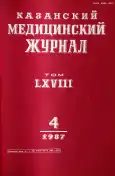Возможности изучения биомеханики дыхания на отечественных пневмотахографах
- Авторы: Пыргарь Д.П.1
-
Учреждения:
- Казанский институт усовершенствования врачей имени В. И. Ленина
- Выпуск: Том 68, № 4 (1987)
- Страницы: 265-268
- Тип: Статьи
- URL: https://journals.rcsi.science/kazanmedj/article/view/96130
- DOI: https://doi.org/10.17816/kazmj96130
- ID: 96130
Цитировать
Полный текст
Аннотация
Для изучения некоторых параметров функции внешнего дыхания в практической медицине обычно используются спирографический и пневмотахометрический методы. Поскольку их возможности ограничены, для более глубокого исследования целесообразно применять такие методы, как пневмотахографический, плетизмографический и др. Отечественные пневмотахографы с интегратором, а также пневмотахографы ПТГ 3-01 производства СКТБ «Медфизприбор» удобны для изучения таких показателей биомеханики дыхания, как работа дыхания, эластичность и растяжимость легких, бронхиальное сопротивление, бронхиальная проходимость. Принцип работы пневмотахографа основан на регистрации колебаний транспульмонального давления и дыхательного объема (V) во время дыхательного цикла, при этом вычерчивается петля работы дыхания, по которой рассчитывают общую работу дыхания и ее составляющие — эластический и неэластический компоненты. Одновременно по петле можно вычислить растяжимость и эластичность легких.
Ключевые слова
Полный текст
Открыть статью на сайте журналаОб авторах
Д. П. Пыргарь
Казанский институт усовершенствования врачей имени В. И. Ленина
Автор, ответственный за переписку.
Email: info@eco-vector.com
Россия, Казань
Список литературы
- Зябрев Ю. П., Алтынбеков Б. Е., Абдрашитова Г. А., Зародин Н. В.//В кн.: Вентиляционная функция легких.— Алма-Ата, 1980.
- Клемент Р. Ф., Кузнецова В. К.//В кн.: Функциональные методы исследования в пульмонологической практике.— Л., 1976.
- Кобулия Б. Г., Бахтадзе Г. Г., Хеладзе M. М., Зоделава М. И.//Тер. арх., 1982.— № 12.— С. 68—72.
- Тетенев Ф. Ф.//В кн.: Биомеханика дыхания. Томск, 1981.
- Шик Л. Л., Канаев H. Н.//В кн.: Руководство по клинической физиологии дыхания.— Л., 1980.
- Black L. F., Olford К., Hyatt R. G.//Amer. Rew. Respir. dis.— 1974.— Vol. 110.— P. 282.
- Cherniak R., Farhi L., Armstrong B., Proctor D.//J. Appl. Physiol.— 1955.— Vol. 8.— P. 208—211.
- Dornhorst A., Leathart G.//Lancet— 1952.— Vol. 263.— P. 109—111.
- Walter S., Nancy N. R., Collier С. R.//Amer. Rew. Respir. dis.— 1979.— Vol. 119.— P. 717—724.
Дополнительные файлы











